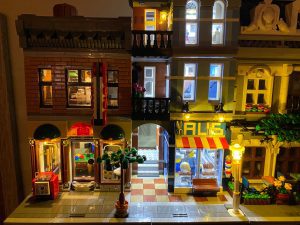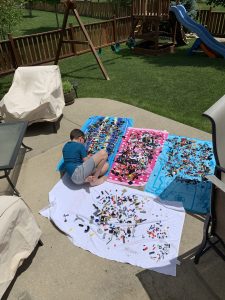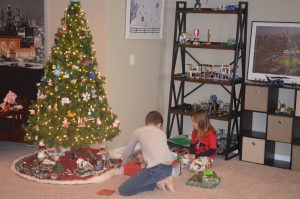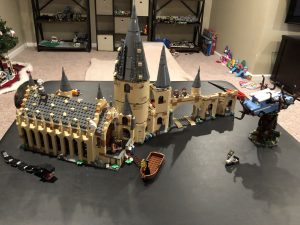 Recently, my husband and I found ourselves in the Lego Store, alone, without kids. We both have an affinity for these colorful bricks, and we love perusing the sets without a child begging us to buy. them. all. As a child, Matt fondly remembers the excitement and angst he felt as every birthday and Christmas got closer. The days wore on, grandparents arrived, food was prepared, consumed, and finally it was time for the best part, the gift-opening. His parents would always require a quick guess as to what was inside before the paper was ripped free and the fun started. The size, shape, and most importantly, the sound would give it away. In old home movies, you can see his face light up just as our son’s does today when he hears the same distinct sound. He loved to hear the rattling that could only mean one thing – LEGOS!
Recently, my husband and I found ourselves in the Lego Store, alone, without kids. We both have an affinity for these colorful bricks, and we love perusing the sets without a child begging us to buy. them. all. As a child, Matt fondly remembers the excitement and angst he felt as every birthday and Christmas got closer. The days wore on, grandparents arrived, food was prepared, consumed, and finally it was time for the best part, the gift-opening. His parents would always require a quick guess as to what was inside before the paper was ripped free and the fun started. The size, shape, and most importantly, the sound would give it away. In old home movies, you can see his face light up just as our son’s does today when he hears the same distinct sound. He loved to hear the rattling that could only mean one thing – LEGOS!
When we had our own children, there was no doubt that they would need to be surrounded by as much love, books, and Legos as possible. Our parents held onto the Legos we owned, so they’d be ready when the grandkids visited. We started out early and hard with Duplos. They were a short experience and met with mixed success. They were a win because no one choked and no one was forced to take ipecac to remove a Lego tire from their stomach, as my husband had. The only problem was the Duplos didn’t seem to excite our kids.

One day, we decided it was time to bring in the “big kid” Legos. Our kids took to them like little fish to water. Soon, it was the top-requested gift for all occasions. Individually-packaged mini-figures became the all-important motivator, coercer, and reward for making it through some event without falling apart and forcing poor parenting decisions. My parents saw their excitement and were soon hunting garage sales throughout the tri-county area for tubs of Legos, complete or incomplete sets. Our kids would spend hours poring over the new finds (after we’d sanitized them in the washing machine…seriously), looking for the coolest new pieces.
Now, with every joy comes a little challenge. For us, it was how to manage all the Legos. Like every toy, they ended up in our basement and soon took over. Will’s completed sets of Batman, Star Wars, and creations of his own imagination filled the bookshelves. Emma’s Lego Friends sets replaced Thomas on the train table and spilled onto the floor. Our family movie-watching, game-playing basement was soon turned into a Lego minefield, as pieces became partially swallowed up in our shag carpet. The sharp angles were exposed just enough to gouge a foot or elicit a hushed swear word. We needed a plan. After a number of trips to Target and The Container Store we settled on a three-part system of organization.
Essential free-play Legos – a little pile of wonder and imagination
The challenge was how to provide organization and sense to the random piles of Legos, while allowing the fun of finding the unknown. Every time we picked up Legos, our son was upset that we were destroying something important. He loved the hunt – stirring the pot of Legos on the floor, looking for just the right piece. We loved watching this. It was fun to watch his brain at work as he debated the function of each piece. Because of this, we still have several tubs full of mixed pieces that are unorganized and at the ready for our son to find inspiration.

Favorite completed builds – for celebration and sense of accomplishment
As parents and teachers, we have seen how important it is for our children to celebrate their ability to find their own feeling of accomplishment. Not a group effort or a big production, but just something that builds a sense of confidence that they can try and fail, and that it will end in something they can be proud of. But, let’s be real. We can’t save every Lego creation, so this is where the second part of our storage system comes into play. We use shelves from Costco to hold completed builds and force decisions by limiting how much we can save. It’s important for our kids to see that you can’t have everything and that making choices to be flexible and removing old builds leaves room for more.
Replacement pieces for the future
The last type of organization are the rolling carts of bricks, sorted by color or type (wheels, windows, etc). These pieces are easily accessible when a large build starts. The best part of this is that, once a year, during a snow day or a free weekend, we do the “big sort.” This yearly pairing-down of our aforementioned free-play pile is a time where past favorite pieces are found and passion is reborn for our kids. It’s also a time we all enjoy listening to music and talking about life. We slow down, focus on something fun and just enjoy each other.
It is difficult to find balance between providing a chance to create while being able to protect your feet. But we feel like we may have found a temporary balance. How do you store Legos? I’d love to hear your ideas!

















With 3 boys we found our wsy to the same type of system. Free play slides out under bed.
Shelves for builds snd carts with drawers. Within the last category, our more specific kid wanted types and he a specific small drawer organizer for by type.
One detail: the storage needs to be shallow not deep. Shallow means the legos can be moved around within container. Deep means it gets dumped out = mess.